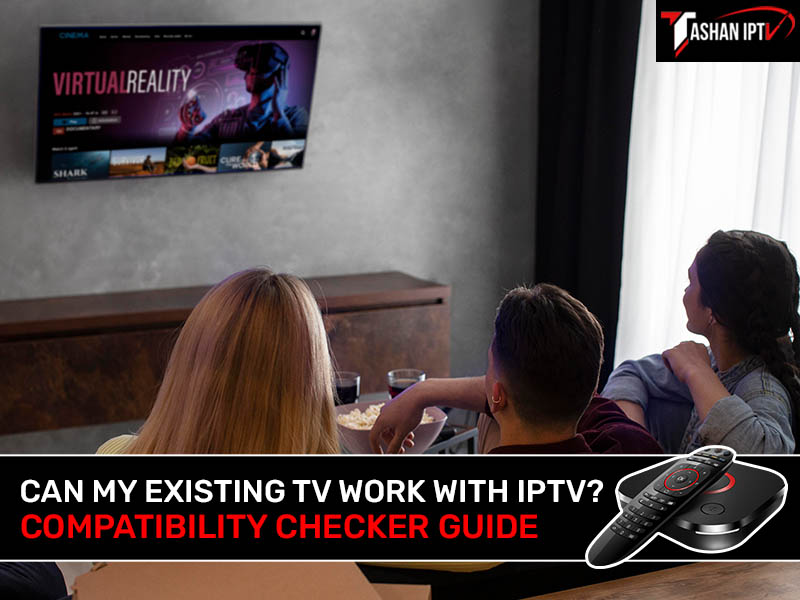24x7 Customer Support
24x7 Customer Support

Not every TV connects the same way to IPTV. Some models are ready from the start, while others need a few extra steps. This guide walks through how different TVs handle IPTV and what’s needed to start streaming.
IPTV stands for Internet Protocol Television. It streams live channels and shows over the internet instead of using satellite or cable. This means everything comes through a stable internet connection. Services use apps or set-top boxes to give access to movies, TV channels, and more.
Most smart TVs work well with IPTV. To get started, install an IPTV app like Smart IPTV, IPTV Smarters, or TiviMate. These apps accept playlist links, also called M3U URLs, given by the IPTV provider. Once installed and activated, the TV loads channels straight from the app.
Not all apps are free, and some require a one-time payment after a trial. Using a remote, users can switch channels, browse guides, or stream catch-up TV if supported.
Older TVs can’t install IPTV apps directly. They don’t have smart features or access to app stores. Still, it’s possible to use IPTV on these TVs with help from devices like Amazon Fire Stick, Android TV boxes, or MAG set-top boxes. These tools plug into the HDMI port and handle everything needed for IPTV.
Older models must have at least one HDMI input and work with a standard remote. Once the device connects, it acts like a mini-computer that shows IPTV on the screen.
Smart TVs often don’t need extra boxes. They install IPTV apps and stream directly. Non-smart TVs or models that don’t support certain apps will need a set-top box or streaming stick.
Some users still choose set-top boxes, even for smart TVs, to boost performance or get a better experience. IPTV apps often work faster and crash less on boxes like MAG540W3 or MAG555.
Connecting IPTV to a non-smart TV is simple with the right device. First, choose a streaming stick or box that supports IPTV apps. Plug it into the HDMI port. Switch the TV to the HDMI input, then connect the device to Wi-Fi.
Next, install an IPTV app. Enter the M3U URL or login details from the IPTV provider. The device handles everything from loading channels to playing them on the screen.
Some users also use AV-to-HDMI converters for very old TVs, though picture quality might drop.
IPTV needs a steady internet connection. It doesn’t work over traditional antenna or cable lines. Streaming uses data, and live HD channels often need speeds of 10 Mbps or more. Watching IPTV without internet isn’t possible.
Some services offer offline downloads on mobile apps, but these still need internet to fetch the content first. For home use, Wi-Fi or wired Ethernet gives the best results.
Several apps work well for IPTV. Smart IPTV is popular on Samsung and LG models. IPTV Smarters is flexible and supports multiple accounts and EPGs (Electronic Program Guides). TiviMate is widely used on Android TV and offers a modern layout.
These apps support playlist links and load channels in seconds. Some come with extra features like catch-up TV, favorites, and built-in players. While some apps are free, premium versions often provide smoother control and better layouts.
Android TV allows more freedom when installing IPTV apps. Use Google Play Store to search and install apps like TiviMate, IPTV Smarters, or XCIPTV. Once installed, open the app and add login details or a playlist link from the IPTV provider.
For apps not on the Play Store, users can sideload them using APK files. To install it manually, go to settings and turn on unknown sources. Then download the APK.
Both smart TVs and set-top boxes support IPTV, but each has strengths. Smart TVs are easier since they come with app stores. But over time, TVs may stop getting updates, and apps might stop working well.
Set-top boxes often stay updated longer. They run IPTV apps more smoothly and allow more custom settings. For long-term use and better performance, many choose dedicated Android TV boxes or IPTV set-top boxes.
Getting IPTV to work takes a few quick steps:
The setup takes 10–15 minutes if the right tools are in place.
Some common problems include no video, app freezing, or channels not loading. Most problems may be fixed by restarting the device and verifying the internet connection.
Make sure the IPTV app is updated. Check if the playlist link or account is still active. If buffering continues, lowering the stream quality can help. Using a physical connection instead of Wi-Fi also makes things work better.
Most TVs work with IPTV in some way. Smart TVs install apps directly. Older TVs connect through external devices. As long as the TV has an HDMI port and a good internet connection, IPTV is within reach.
Streaming starts with the right provider, a working app, and a simple setup. Whether using a built-in app or a dedicated set-top box, IPTV turns any screen into a powerful TV hub.
For subscription plans and more IPTV tools, explore what’s offered at tashantv.com.